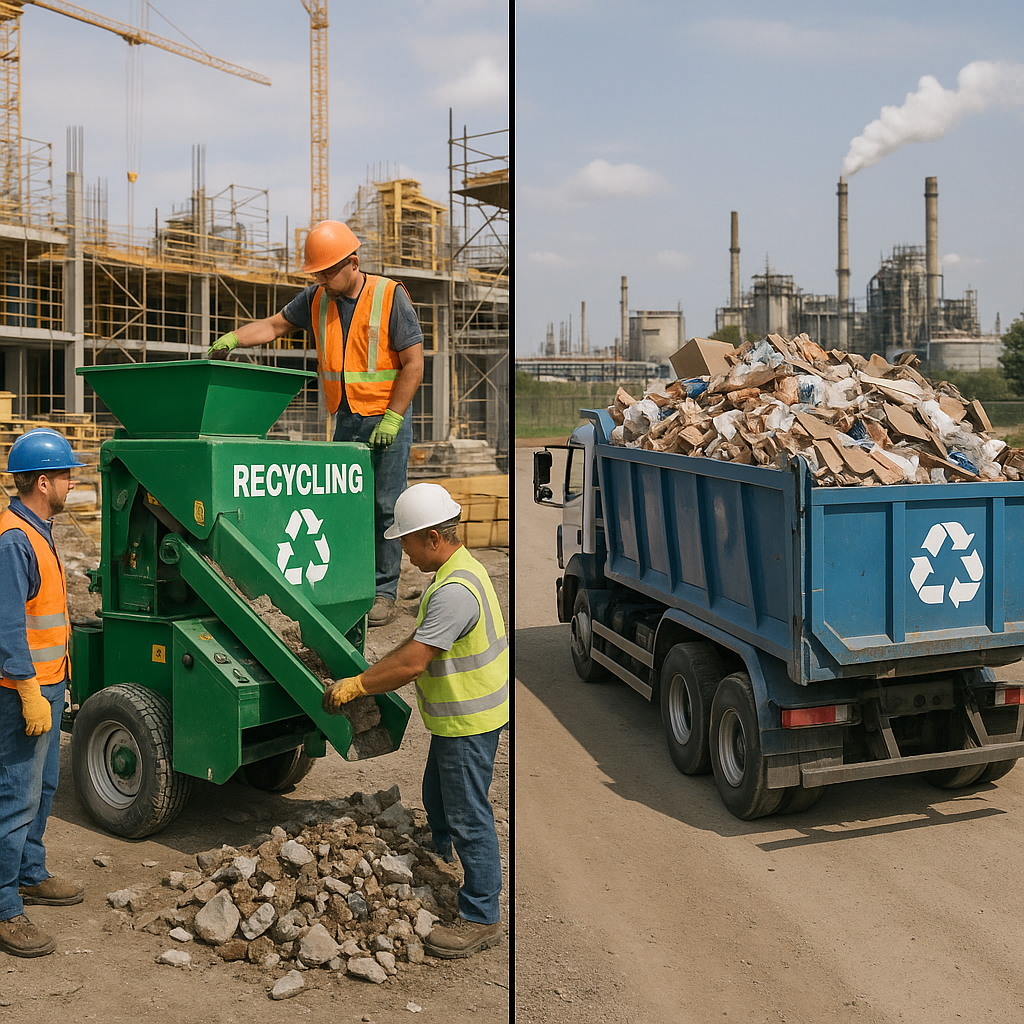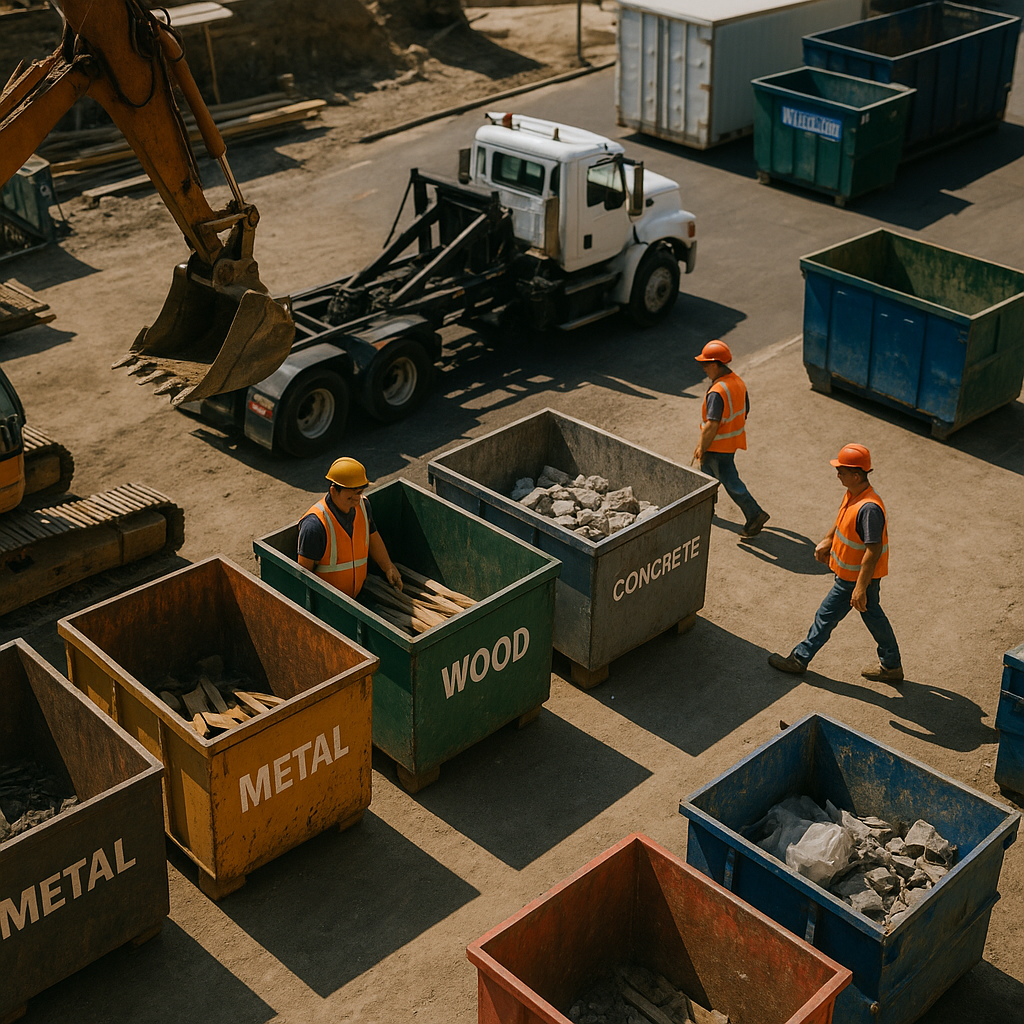5901 Botham Jean Blvd, Dallas, TX 75215
What is the Difference Between On-Site and Off-Site Recycling?
August 14, 2025Construction and demolition projects generate substantial waste that can be recycled instead of sent to landfills. There are two main approaches to managing these materials: on-site and off-site recycling. Each method offers unique advantages depending on project needs and constraints.
On-site recycling involves separating materials into multiple designated dumpsters at the construction site. Workers sort debris as they go, placing wood, metal, concrete, and other recyclables into their respective containers. These materials are then taken to specialized recycling facilities that process each type. This approach is also known as source-separated recycling.
Off-site recycling follows a different method. All recyclable materials are placed into a single dumpster as a mixed or commingled load. Once filled, the container is transported to a recycling facility where workers and machinery separate the materials. This method simplifies the on-site process but shifts sorting responsibility to specialized facilities with advanced sorting technology.
What Are the Cost Implications of On-Site vs Off-Site Recycling?

Construction and demolition projects generate significant waste, which can be managed via on-site or off-site recycling methods. Each approach has distinct financial implications that can notably affect your project budget.
Initial Cost Considerations
Off-site recycling generally requires a lower upfront investment. This method reduces the need for multiple dumpster rentals and fewer hauler deliveries at your project site. By using a single commingled waste container, you minimize equipment costs and simplify logistics.
On-site recycling involves greater initial capital. Multiple containers are necessary for separating materials like concrete, metal, wood, and cardboard. The average dumpster rental costs over $400 per unit nationwide. When multiplied by the number of materials separated, costs increase rapidly.
Labor costs differ between methods. Off-site sorting minimizes the need for worker training and time spent on-site separation. Conversely, on-site recycling requires training crew members on proper disposal procedures and oversight to ensure compliance.
Long-Term Financial Benefits
While on-site recycling has higher initial costs, it can offer better long-term financial returns. Separating materials at the source prevents contamination and maintains material quality. This usually results in higher recycling rebates and better prices for recyclables.
Transportation expenses considerably affect total costs. Off-site recycling needs fewer trucks at your site but still requires transport to processing facilities. On-site recycling might involve more truck traffic, increasing fuel costs and emissions.
Material sales can substantially offset costs. Well-sorted materials like metals, clean wood, and concrete have market value. Medium-sized projects can recoup thousands of dollars through strategic sales of segregated recyclables.
| Cost Element | On-Site Recycling | Off-Site Recycling |
|---|---|---|
| Initial Investment | Higher due to multiple dumpster rentals | Lower due to fewer dumpster rentals |
| Labor Costs | Higher for sorting and training | Lower, minimal sorting needed |
| Transportation Expenses | Potentially higher due to increased truck traffic | Less truck traffic, but still requires facility transport |
| Recycling Rebates | Higher due to clean separation | Potentially lower due to contamination |
| Space Requirements | More space needed for multiple containers | Minimal space needed |
| Material Sales Potential | Higher potential due to better sorting | Lower potential due to mixed materials |
Project-Specific Factors
Space availability often dictates the recycling approach. Urban sites with limited area may find it impractical to accommodate several sorting containers. As William Turley, Executive Director of the Construction & Demolition Recycling Association, observes, “Trying to squeeze four or five dumpsters in a small lot might not be possible.”
Project scale influences cost-effectiveness. Larger projects generate more waste, potentially justifying on-site processing equipment or dedicated sorting areas. Smaller projects may benefit from the simplicity of off-site options.
Local recycling infrastructure affects your decision. The proximity and capability of nearby recycling facilities influence transportation costs and potential rebates. Some regions have advanced facilities with high recovery rates from commingled waste; others may need pre-sorted materials.
Conducting a Thorough Cost-Benefit Analysis
A comprehensive analysis should incorporate both direct and indirect costs. Direct expenses include container rentals, transportation, processing fees, and labor. Indirect costs involve administrative overhead, potential delays, and site congestion.
The time investment is crucial. On-site sorting might slow project aspects or require extra planning. This time must be compared with potential financial returns from higher material rebates.
Environmental regulations increasingly affect project economics. Many municipalities now require minimum recycling rates for construction projects. Non-compliance can lead to fines or delays that exceed the cost differences between methods.
Hybrid Approaches for Maximum Value
Many projects employ hybrid recycling strategies. You might use separate containers for metals while commingling other recyclables. This approach maximizes returns while controlling costs.
For example, a retail construction project might use dedicated containers for concrete and metals while commingling others. This strategy focuses efforts on high-rebate materials while simplifying lower-value materials management.
The optimal strategy balances immediate project constraints with long-term goals. A thorough cost-benefit analysis based on your specific project parameters will reveal whether on-site, off-site, or a hybrid model offers the best financial outcome.
How Do Environmental Impacts Compare Between On-Site and Off-Site Recycling?

On-site recycling generally results in less landfill waste than off-site methods. When materials are sorted directly at the construction site, the risk of contamination is reduced. This ensures more materials remain suitable for recycling instead of ending up in landfills. Construction firms that embrace on-site sorting have reported waste diversion rates up to 90% in some projects, significantly lessening the environmental impact of construction waste.
However, on-site recycling has its own environmental challenges. It requires using multiple dumpsters for different materials, necessitating more truck trips to and from the site. This increases carbon emissions and air pollution. A typical commercial construction project might need 4-5 separate containers for various materials, potentially quadrupling transportation-related emissions compared to using a single commingled dumpster.
Off-site sorting, while seemingly less efficient initially, can achieve similar diversion rates thanks to advanced recycling facilities. These facilities use optical sensors, AI-powered robots, and mechanical systems to separate materials with high precision. Such technologies enable recycling rates comparable to or even surpassing manual on-site sorting, especially when construction workers are not adequately trained in material separation.
The environmental impact becomes more complex when considering transportation distances. If recycling facilities are far from construction sites, the carbon footprint from transportation increases significantly. Studies indicate that transportation emissions can outweigh recycling benefits when distances exceed certain thresholds. For heavy materials like concrete, this distance may be as low as 20-30 miles before environmental costs begin to undermine recycling benefits.
Local infrastructure is crucial in determining the more eco-friendly approach. In areas with nearby advanced recycling facilities, off-site sorting may lead to a smaller overall carbon footprint despite commingled collection. Conversely, in regions where facilities are limited or far away, on-site sorting might be more environmentally advantageous, even with the increased vehicle traffic.
Technology at recycling facilities also impacts the environmental effect. Facilities with state-of-the-art sorting equipment recover more materials from commingled waste. For instance, advanced facilities can recover up to 95% of metals, 90% of concrete, and 70% of wood from mixed construction waste. These recovery rates significantly narrow the environmental gap between on-site and off-site sorting methods.
Project scale also affects environmental impact calculations. Larger projects produce more waste, making on-site sorting more efficient as the volume justifies dedicated recycling streams. The Green Tower residential project in New York City exemplified this by achieving 87% waste diversion through comprehensive on-site sorting, overcoming urban constraints with proper planning.
Another crucial environmental aspect is the embodied carbon in construction materials. Recycling materials like steel, aluminum, or copper, rather than landfilling them, leads to significant energy savings compared to producing these materials from raw resources. Recycling one ton of steel saves approximately 2,500 pounds of iron ore, 1,400 pounds of coal, and 120 pounds of limestone, significantly reducing the carbon footprint whether the sorting is done on-site or off-site.
What Are the Logistical Considerations for On-Site vs Off-Site Recycling?

The logistical aspects of recycling operations significantly impact project efficiency, timeline, and budget. When deciding between on-site and off-site recycling, several key operational factors extend beyond simple cost considerations.
Space Requirements
On-site recycling demands considerable space allocation for multiple dumpsters and sorting areas. A typical construction project implementing on-site sorting requires separate containers for wood, metal, concrete, plastic, and other materials. This requirement becomes particularly challenging in urban construction sites where every square foot counts.
The executive director of the Construction & Demolition Recycling Association noted, “space is always a challenge, especially in crowded downtown areas. Trying to squeeze four or five dumpsters in a small lot might not be possible.” Off-site recycling, by contrast, requires minimal space as it typically uses just one or two commingled containers, preserving valuable site area for construction activities, equipment staging, and material storage.
Traffic Flow and Site Workflow
The movement of vehicles and personnel around recycling areas can create significant logistical challenges. On-site recycling increases traffic from multiple haulers servicing different material containers, which can create bottlenecks that slow down other site operations.
More dumpsters also mean more delivery and pickup schedules to coordinate, potentially disrupting construction workflows when trucks block access to work areas during critical phases. Off-site sorting streamlines site traffic patterns by requiring fewer dumpster deliveries and pickups, maintaining smoother operations and minimizing disruptions to the construction schedule.
Personnel Training and Management
Effective on-site recycling requires substantial investment in worker training. Employees need clear guidance on proper material sorting and contamination prevention, demanding time and resources that could be directed toward core construction activities.
Ongoing management of on-site recycling operations requires continuous oversight to ensure proper sorting. Site supervisors must monitor compliance and address issues promptly to prevent contamination of recyclable streams. Off-site recycling shifts the sorting burden to specialized facilities with trained personnel, requiring minimal training for on-site workers beyond basic waste disposal practices, allowing them to focus on their primary responsibilities.
Contamination Management
Material contamination presents a significant logistical challenge for both recycling approaches. When recyclables become contaminated with non-compatible materials, entire loads may be rejected by processing facilities.
On-site recycling provides better contamination control through immediate sorting but requires vigilant oversight. Workers can identify and correct sorting errors before materials leave the site, reducing the risk of rejected loads. Off-site recycling faces higher contamination risks since materials are commingled. If loads are rejected due to contamination, significant delays can occur while replacement dumpsters are delivered, impacting project timelines and creating waste management bottlenecks.
Timeline Considerations
Project timelines often influence recycling approach decisions. On-site recycling requires more initial setup time to establish sorting stations, train personnel, and implement management systems. This front-loaded time investment can impact early project phases.
The off-site approach allows for faster initial implementation since it requires minimal setup, valuable for projects with tight deadlines or aggressive schedules. However, off-site recycling can introduce timeline vulnerabilities if contaminated loads are rejected. Delays while waiting for replacement containers can disrupt critical path activities if waste management operations fall behind schedule.
Site Constraints and Flexibility
Each construction site has unique physical constraints that influence recycling logistics. Limited access points, narrow roads, or underground utilities may restrict container placement options for on-site recycling. Off-site recycling offers greater flexibility for adapting to site constraints since it requires fewer containers. This adaptability is valuable for projects with challenging site conditions or limited access.
Hybrid approaches combining elements of both methods can help overcome site-specific constraints. For example, some projects use on-site sorting for high-volume materials like concrete while using commingled containers for other recyclables.
Workforce Availability
The availability of qualified workers influences recycling approach decisions. On-site recycling requires more labor resources for sorting and management activities. In markets with workforce shortages, allocating personnel to recycling operations may divert resources from core construction activities.
Off-site recycling minimizes workforce requirements on the construction site, a significant advantage during peak construction phases when every worker is needed for project advancement. The choice between approaches often depends on workforce availability, skill levels, and project needs. Contractors must balance recycling goals with overall project staffing requirements to maintain efficient operations.
Conclusion: Choosing Between On-Site and Off-Site Recycling

Choosing between on-site and off-site recycling ultimately depends on your project’s unique requirements. On-site recycling often results in higher recycling rates and better material quality, making it suitable for projects with strict sustainability goals and enough space. While this approach might need more initial investment, it can yield greater financial returns through higher-quality recyclable materials and reduced long-term disposal costs.
Off-site recycling, on the other hand, provides simplicity and convenience with lower initial costs. It is ideal for space-constrained sites or projects with limited resources for waste sorting. The decision also hinges on local recycling infrastructure and capabilities, along with factors like timeline, budget constraints, and environmental objectives specific to the project. For personalized guidance tailored to your recycling needs, contact Okon Recycling at 214-717-4083.
